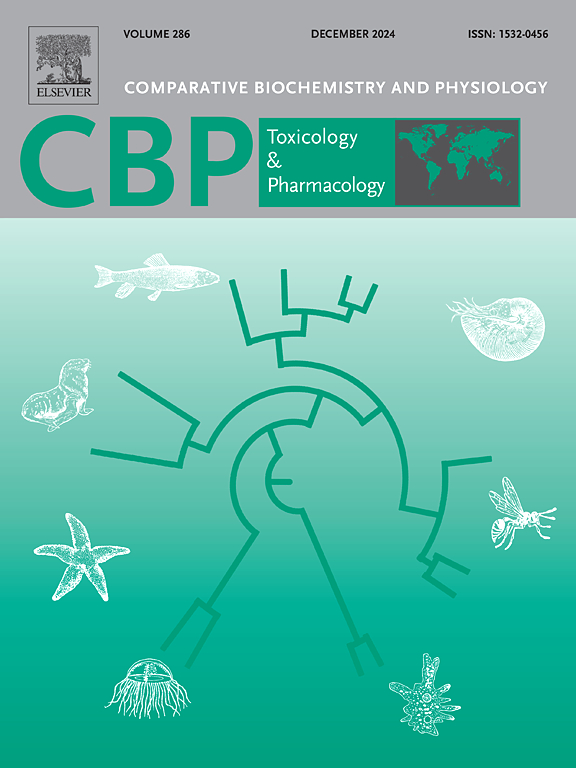急性暴露于氮氧吡啶对淡水蜗牛胚胎和幼螺的影响
IF 3.9
3区 环境科学与生态学
Q2 BIOCHEMISTRY & MOLECULAR BIOLOGY
Comparative Biochemistry and Physiology C-toxicology & Pharmacology
Pub Date : 2025-04-21
DOI:10.1016/j.cbpc.2025.110209
引用次数: 0
摘要
偶氮杀菌剂(Azoxystrobin, AZ)是一种应用于土壤的系统杀菌剂,用于防治多种植物病原真菌。由于过量释放,在地表水中检测到阿斯利康残留,对水生生物构成威胁。本研究评价了短时间暴露于AZ对海蚕胚胎和幼虫的毒性作用。首先,AZ对胚胎96 h LC50值为7.98 (6.50 ~ 9.85)mg/L,幼鱼96 h LC50值为2.90 (2.30 ~ 3.86)mg/L,表明幼鱼对AZ急性毒性更为敏感。另外还进行了亚致死试验,以评估AZ对胚胎和幼鱼的亚致死效应。最高亚致死暴露浓度约为胚胎和幼鱼各自LC50估定值的20%,而较低浓度则通过连续10倍稀释来确定,以包括与环境相关的AZ水平。因此,胚胎暴露于0、15、150和1500 μg/L,而幼体暴露于0、5、50和500 μg/L,持续96 h。在1500 μg/L的浓度下,暴露于AZ会导致胚胎发育迟缓、生长减慢、孵化成功率降低和死亡率降低。同样,幼蜗牛在所有测试浓度下都表现出明显的生化和分子变化。观察到az诱导的ROS生成和MDA水平升高,同时SOD、CAT、GPx和GR活性升高。此外,即使在最低暴露浓度下,幼体中HSP40、HSP70、SOD、CAT、GPx和GR的mRNA转录也上调。综上所述,AZ污染对淡水腹足动物的早期生命阶段具有显著的生态风险。本文章由计算机程序翻译,如有差异,请以英文原文为准。

Effects of acute exposure to azoxystrobin on embryos and juveniles of the freshwater snail Lymnaea stagnalis
Azoxystrobin (AZ) is a systemic fungicide applied to soil to control a wide range of plant pathogenic fungi. AZ residues have been detected in surface waters due to excessive release, posing a risk to aquatic organisms. This study evaluated the toxic effects of short-term AZ exposure on embryos and juveniles of Lymnaea stagnalis. First, the 96-h LC50 values of AZ were estimated as 7.98 (6.50–9.85) mg/L for embryos and 2.90 (2.30–3.86) mg/L for juveniles, indicating that juveniles are more sensitive to acute AZ toxicity. Additional experiments were conducted to assess the sublethal effects of AZ on embryos and juveniles. The highest sublethal exposure concentrations were set at approximately 20 % of the respective estimated LC50 values for embryos and juveniles, while the lower concentrations were determined by successive ten-fold dilutions to include environmentally relevant AZ levels. Accordingly, embryos were exposed to 0, 15, 150, and 1500 μg/L, whereas juveniles were exposed to 0, 5, 50, and 500 μg/L over a 96-h period. In embryos, AZ exposure led to developmental delays, reduced growth, decreased hatching success and mortality at 1500 μg/L. Likewise, juvenile snails displayed marked biochemical and molecular alterations across all tested concentrations. AZ-induced ROS generation and elevated MDA levels were observed, alongside increased activities of SOD, CAT, GPx, and GR. Additionally, mRNA transcripts of HSP40, HSP70, SOD, CAT, GPx, and GR were upregulated in juveniles, even at the lowest exposure concentration. In conclusion, AZ contamination poses a significant ecological risk to the early life stages of freshwater gastropods.
求助全文
通过发布文献求助,成功后即可免费获取论文全文。
去求助
来源期刊
CiteScore
7.50
自引率
5.10%
发文量
206
审稿时长
30 days
期刊介绍:
Part C: Toxicology and Pharmacology. This journal is concerned with chemical and drug action at different levels of organization, biotransformation of xenobiotics, mechanisms of toxicity, including reactive oxygen species and carcinogenesis, endocrine disruptors, natural products chemistry, and signal transduction with a molecular approach to these fields.

 求助内容:
求助内容: 应助结果提醒方式:
应助结果提醒方式:


